| Top Ten NYC Architecture | top ten midtown buildings | |||||||||||||||
| For a more complete list, see MIDTOWN | ||||||||||||||||
| 1 |
General Electric B |
|||||||||||||||
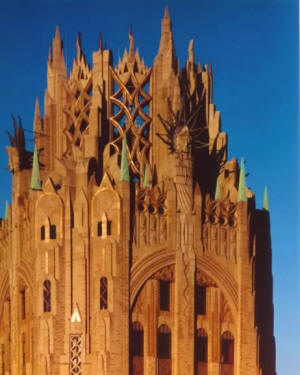 |
The General Electric Building is a historic 50-floor skyscraper in Midtown New York City, United States, at 570 Lexington Avenue (southwest corner of Lexington and 51st Street). Originally known as the "RCA Victor Building" when designed by Cross and Cross in 1931, and sometimes known by its address to avoid confusion with the later GE Building at 30 Rockefeller Center. It backs up to the low Byzantine dome of St. Bartholomew's Church on Park Avenue and shares the same salmon brick color. But from Lexington, the building is an insistently tall 50-floor stylized Gothic tower with its own identity, a classic Art Deco visual statement of suggested power through simplification. The base contains elaborate, generous masonry, architectural figural sculpture, and at on the corner above the main entrance, a conspicuous corner clock with the curvy GE logo and a pair of silver disembodied forearms. The crown of the building is a dynamic-looking burst of Gothic tracery, which is supposed to represent radio waves, and is lit from within at night. |
|||||||||||||||
| 2 | Chanin Building | |||||||||||||||
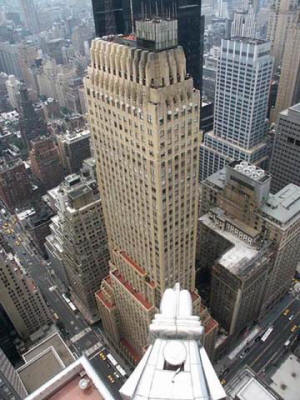 |
The Chanin Building is a skyscraper located at 122 East 42nd Street in New York City. Built by Irwin S. Chanin in 1929, it is 56 stories high, reaching 197.8 metres excluding the spire (207.3 metres/680 feet including spire). It was designed by Sloan & Robertson in the Art Deco style, [1] and incorporates architectural sculpture by Rene Paul Chambellan. When originally completed, the 50th floor had a silver-and-black high-brow movie theater. This floor and the 51st are now offices joined by a stairwell instead. Initially a dominant landmark in the midtown skyline, the building had an open air observatory on the 54th floor. [2] Having been surpassed in height by a number of buildings, most notably, the Chrysler Building located across the street, the observatory has been long closed. |
|||||||||||||||
| 3 |
Chrysler Building |
|||||||||||||||
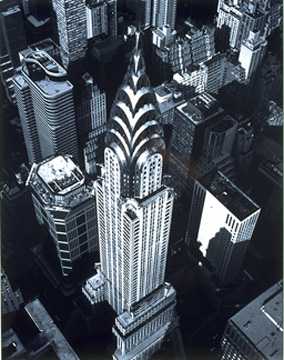 |
|
|||||||||||||||
| 4 | Rockefeller Center | |||||||||||||||
 |
Rockefeller Center is a complex of 19 commercial buildings covering 22 acres between 48th and 51st Streets in New York City. Built by the Rockefeller family, it is located in the center of Midtown Manhattan, spanning between Fifth Avenue and Seventh Avenue. It was declared a National Historic Landmark in 1987. It is the largest privately held complex of its kind in the world, and an international symbol of modernist architectural style blended with capitalism. |
|||||||||||||||
| 5 | GE Building, originally RCA Building | |||||||||||||||
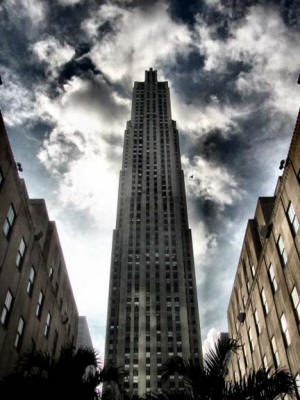 |
The GE Building is an Art Deco skyscraper that forms the centerpiece of the Rockefeller Center in Midtown Manhattan. Known as the RCA Building until 1988, it is famous for housing the headquarters of the television network NBC. At 850 feet (259 meters) tall, the 70-story building is the 8th tallest building in New York City and the 32nd tallest in the United States. The building is sometimes referred to as 30 Rock, a reference to its address at 30 Rockefeller Plaza. |
|||||||||||||||
| 6 |
Empire State Building |
|||||||||||||||
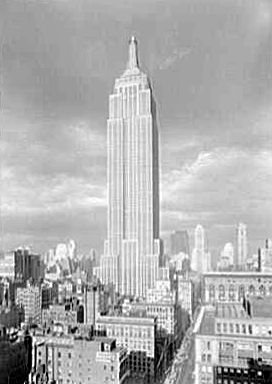 |
The Empire State Building has been named by the American Society of Civil Engineers as one of the Seven Wonders of the Modern World. The building and its street floor interior are designated landmarks of the New York City Landmarks Preservation Commission, and confirmed by the New York City Board of Estimate. It was designated as a National Historic Landmark in 1986. In 2007, it was ranked number one on the List of America's Favorite Architecture according to the AIA. The building is owned by Harold Helmsley's company and managed by its management/leasing division Helmsley-Spear. |
|||||||||||||||
| 7 | Westin Hotel | |||||||||||||||
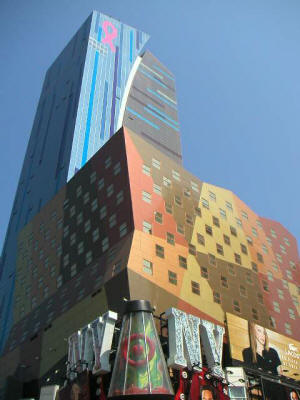 |
The redevelopment of Times Square has finally produced a building worth talking about: the new Westin Hotel on Eighth Avenue between 42nd and 43rd Streets. And people are talking about it for a welcome reason. The Westin has raised a flag over the issue of taste. Translation: many people find it ugly. Hideous. The very embodiment of beauty's evil twin. Look up, people. This is New York. We live in one great ugly town. Not being too hung up on beauty is what makes life here possible, even thrilling. In exchange for surrendering refinement, we get a kind of urban poetry that is the envy of the world. Sometimes it takes outsiders to see it. Often, outsiders introduce new rhymes. The beauty resides, in some sense, in staying an outsider. The Westin is the consummate outsider's hotel. |
|||||||||||||||
| 8 | THE BUSH TOWER | |||||||||||||||
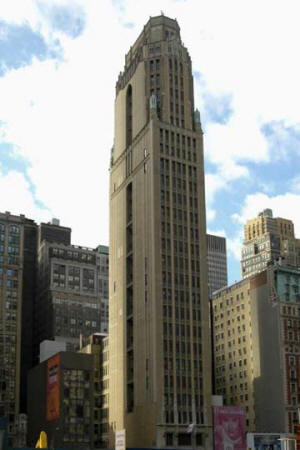 |
THE NARROW 32-story Bush Tower was the first skyscraper built after the Zoning Code of 1916, but it had been designed before the code went into effect. Nonetheless, Harvey Wiley Corbett accurately foresaw how architects would respond to the new setback envelope presented by the code. |
|||||||||||||||
| 9 | Time Warner Center | |||||||||||||||
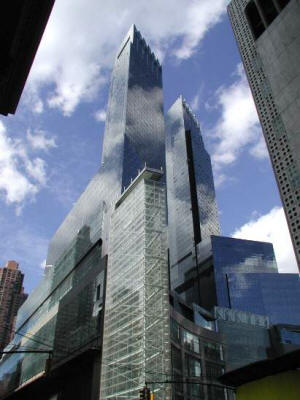 |
Originally constructed as the "AOL Time Warner Center," the building surrounds half of Columbus Circle in Midtown Manhattan. The total floor area of 260,000 m² (2.8 million ft²) is divided between offices (notably the offices of Time Warner Inc.), residential condominiums, and the Mandarin Oriental hotel. The Shops at Columbus Circle is an upscale shopping mall located in a curving arcade at the base of the building, with a large Whole Foods Market grocery store in the basement. The complex is also home to a 1,200 seat theater for Jazz at Lincoln Center as well as CNN studios, from where Anderson Cooper 360° and Lou Dobbs Tonight, among other shows, are broadcast live. CNN's Jeanne Moos, known for her offbeat "man on the street" reporting, frequently accosts her interview subjects just outside the building. In 2005, Jazz at Lincoln Center announced a partnership with XM Satellite Radio which gave XM studio space at Frederick P. Rose Hall to broadcast both daily jazz programming and special events such as an Aartist Confidential show featuring Carlos Santana. |
|||||||||||||||
| 10 | 885 Third Ave Lipstick Building | |||||||||||||||
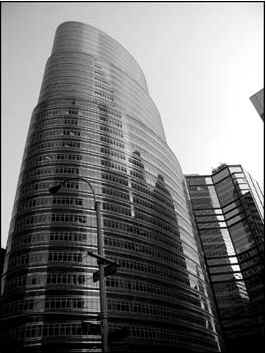 |
The Lipstick Building is Johnson's second postmodern contribution to the Manhattan skyline, following his nearby AT&T Building two years earlier. This time the unusual shape, which has given the building its nickname, was a requirement of the developer, to make the building stand out and compensate for the less fashionable location of Third Avenue. The elliptical shape also claims to make all the exterior offices "corner" offices. |
|||||||||||||||